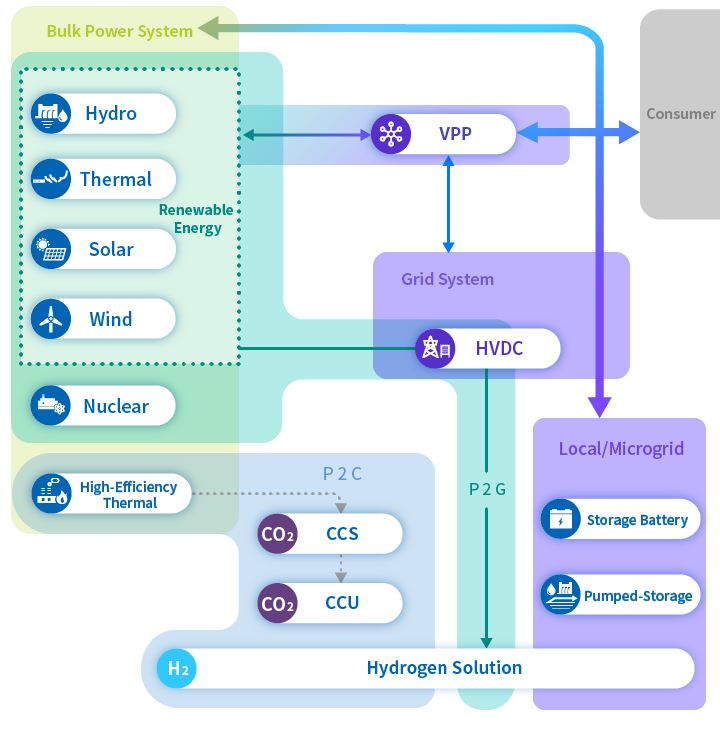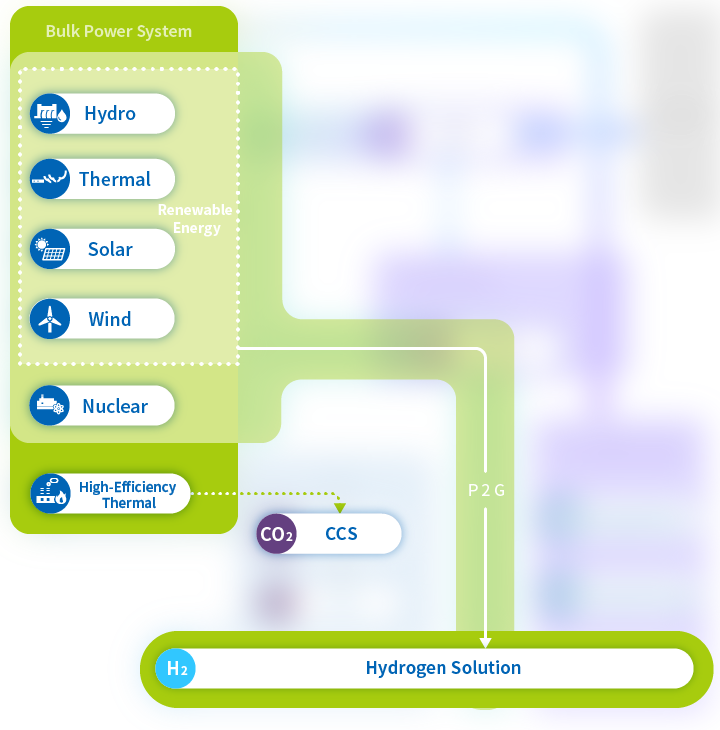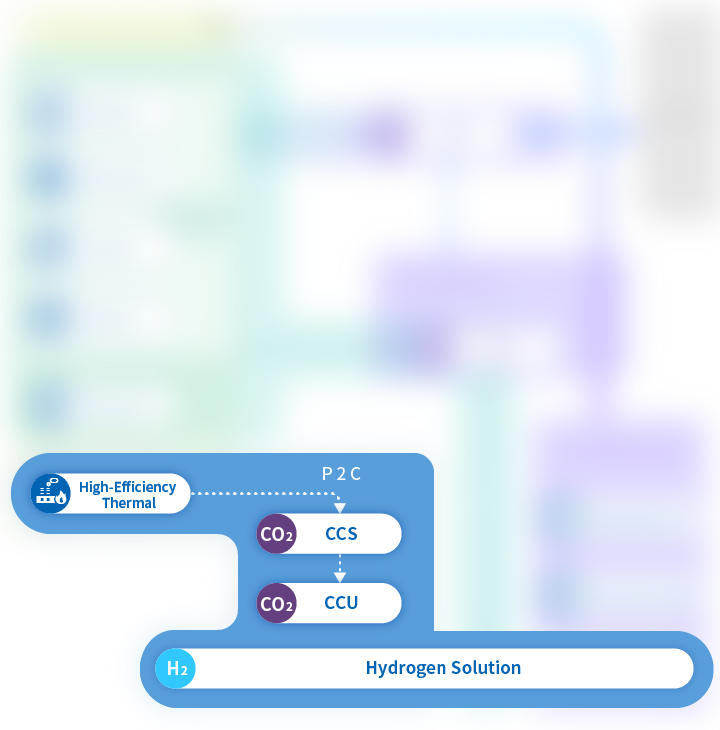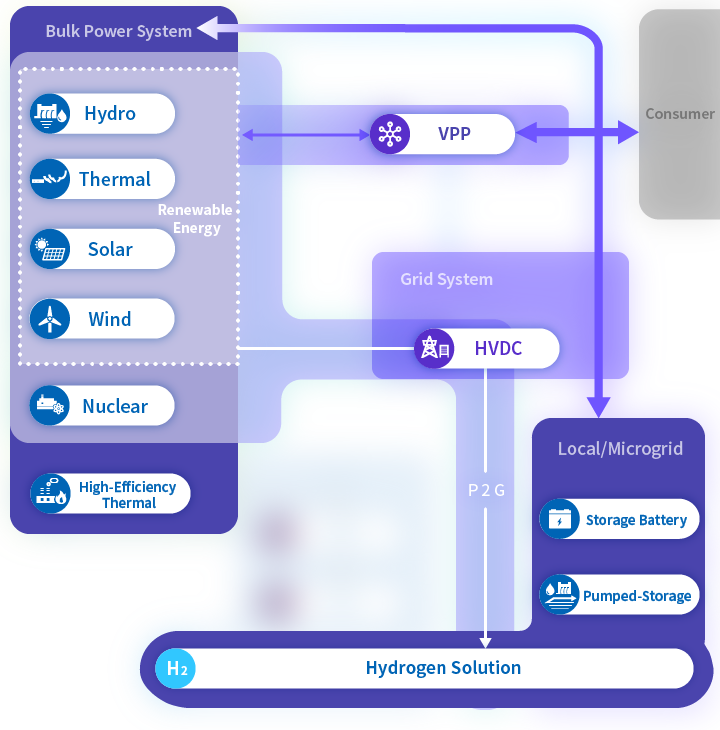Initiatives for Carbon Neutral
Products and Solutions That Contribute to Carbon Neutral Provided by Toshiba Group
With global trend of pursuing carbon neutral, Toshiba is not only running businesses utilizing its wide range of products and services in the generation, distribution, and storage of power, but also actively pursuing carbon capture and utilization technology.
Our business related to decarbonization covers renewable energy, such as hydro, geothermal, and solar power; grid system development, such as high-voltage direct current (HVDC); and stabilization technology, such as supply-demand balance in case the fraction of renewable energy is increased. Furthermore, Toshiba is developing the application of virtual power plant technology, hydrogen technology and carbon dioxide capture, and storage technology for stabilizing power gird. Toshiba provides a wide range of products and technical solutions in all fields of energy, aiming for zero/low emission of CO2, capture/utilization of CO2, and energy adjustment.

 CO2 Zero Emission
CO2 Zero Emission
Low Emission
Renewable energy does not require fossil fuel and emits almost no CO2 during power generation. With this in mind, Toshiba will contribute to the development of renewable energy technology as a main power supply in the future through the improvement of power generation efficiency and by developing next generation photovoltaic module.
Nuclear power generation can also contribute to decarbonization as a power source that does not emit CO2. Toshiba has been engaged in nuclear power business for many years and will continue to make efforts to respond to restarting operations of nuclear power plants with our technical capabilities. In addition, we will also focus on the development of next-generation reactors and advanced reactors.

 Capture/Utilization
Capture/Utilization
Carbon dioxide Capture and Storage (CCS) is a means to separate, capture, and sequester CO2 emissions from its source, such as power plants. As part of this, we are working to establish and promote CO2 capture technology. Carbon dioxide Capture and Utilization (CCU) is a technology that effectively utilizes emitted CO2 as a raw material.
Meanwhile, hydrogen is expected to be utilized in a wide range of fields, and Toshiba is actively working on the development of carbon recycling technology. When the emitted CO2 (such as that captured by CCS) is decomposed by the electric power of renewable energy and combined with hydrogen, it can be recycled again. We call this Power-to-Chemicals (P2C).

 Energy Adjustment
Energy Adjustment
The output of renewable energy depends on time and the various natural environment factors. Technology that combines and levels out various forms of energy is needed for a stable energy supply. Furthermore, adjustments are needed based on not only the supply side but also on the demand volume.
Toshiba will support the introduction of renewable energy with grid system stability by storage technologies, interconnected system technology, including hydrogen use in microgrids, a smart energy management system, which uses digital technology, and HVDC.
In regard to hydrogen solutions, Toshiba is developing Power-to-Gas (P2G) technology.


Renewable energy does not require fossil fuel and emits almost no CO2 during power generation. With this in mind, Toshiba will contribute to the development of renewable energy technology as a main power supply in the future through the improvement of power generation efficiency and by developing next generation photovoltaic module.
Nuclear power generation can also contribute to decarbonization as a power source that does not emit CO2. Toshiba has been engaged in nuclear power business for many years and will continue to make efforts to respond to restarting operations of nuclear power plants with our technical capabilities. In addition, we will also focus on the development of next-generation reactors and advanced reactors.

Carbon dioxide Capture and Storage (CCS) is a means to separate, capture, and sequester CO2 emissions from its source, such as power plants. As part of this, we are working to establish and promote CO2 capture technology. Carbon dioxide Capture and Utilization (CCU) is a technology that effectively utilizes emitted CO2 as a raw material.
Meanwhile, hydrogen is expected to be utilized in a wide range of fields, and Toshiba is actively working on the development of carbon recycling technology. When the emitted CO2 (such as that captured by CCS) is decomposed by the electric power of renewable energy and combined with hydrogen, it can be recycled again. We call this Power-to-Chemicals (P2C).

The output of renewable energy depends on time and the various natural environment factors. Technology that combines and levels out various forms of energy is needed for a stable energy supply. Furthermore, adjustments are needed based on not only the supply side but also on the demand volume.
Toshiba will support the introduction of renewable energy with grid system stability by storage technologies, interconnected system technology, including hydrogen use in microgrids, a smart energy management system, which uses digital technology, and HVDC.
In regard to hydrogen solutions, Toshiba is developing Power-to-Gas (P2G) technology.

Related Products & Services
![]() CO2
CO2
Zero Emission
Low Emission
![]() Capture/
Capture/
Utilization
![]() Energy
Energy
Adjustment


